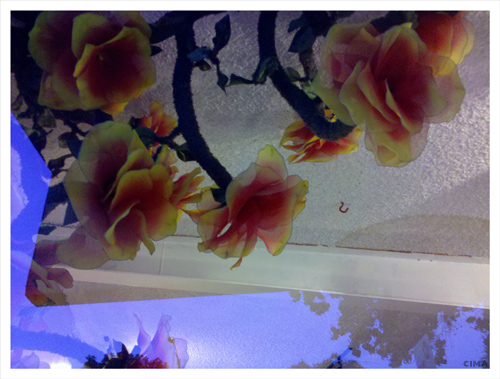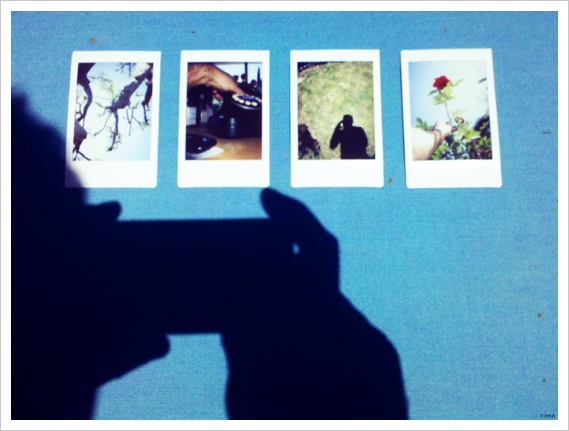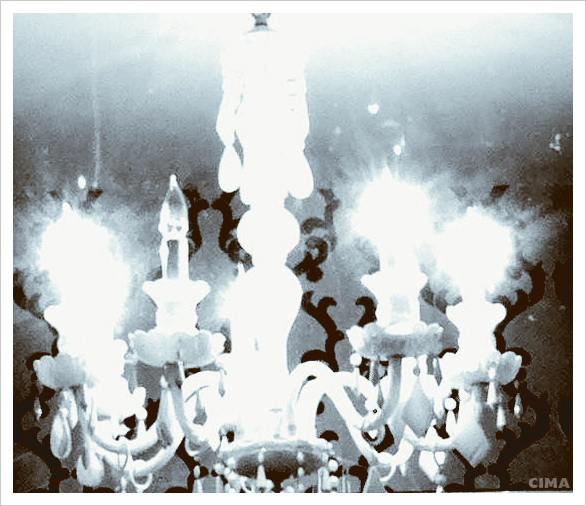Tag Archives: Photography
Photo: Handmade Instant Photo
Photo: Chandelier Through Glass From Parking Lot
Fake Artist Sues Photographer for Taking Pics of Public Sidewalk Art
Some abject fool of an artist named Jack Mackie made a deal with the city of Seattle to embed an artwork called Dancers’ Series: Steps into a sidewalk back in 1979. Then a photographer named Mike Hipple went and did a logical thing; he took a photograph of a public sidewalk with the artwork in it. Now the nitwit fraudulent artist is suing him for using his artwork in a photograph! It’s jackasses like this Mackie dude that need to be put out of business. By this jerk’s reasoning I would have to pay royalties to all of the architects responsible for the design of every single building in the Manhattan skyline if I took a photograph of New York. Ridiculous! This fool is an insult to artists and intellectual property courts all over the country.
The only good thing about this Jack Mackie art is that people get to step on it.
I have an idea for a great photograph. Someone goes up to Seattle with a jackhammer for a 4:00 am dig-and-run operation then takes a photograph of the hole that’s left and its caption reads, ‘Please Fill This Hole.’
And this would be something to do to every public artwork attached to a moronic lawsuit like Mr. Mackie’s. Every time one of these lawsuits is filed, destroy the artwork. Eventually, corporate midgets like Jack Mackie will go away.
And another thing, Mr. Mackie, I recognize the concrete incorporated in your artwork on the sidewalk. It’s extremely distinctive. My uncle owns the mill that made that concrete and he will expect to be compensated for the use of his concrete in your public artwork. You owe him $600,000. He’s coming to collect. His name is Lou. Smile when you open the door.
Polaroid Gets Smart – Brings Back Classic Instant Film Camera
 Polaroid has used the Consumer Electronics Show (CES) in Las Vegas to announce a new line of classic instant film cameras! Called the Polaroid PIC-1000, the camera will work with 10-packs of instant film just like the great old Polaroid cameras of the past. This is a very smart move by a company that looked supremely dumb a few years ago when it canceled the best product it had ever created. It was almost as dumb as Volkswagen canceling the Bug.
Polaroid has used the Consumer Electronics Show (CES) in Las Vegas to announce a new line of classic instant film cameras! Called the Polaroid PIC-1000, the camera will work with 10-packs of instant film just like the great old Polaroid cameras of the past. This is a very smart move by a company that looked supremely dumb a few years ago when it canceled the best product it had ever created. It was almost as dumb as Volkswagen canceling the Bug.
But no worries, we will have our instant pictures back. Not even digital cameras are instant. Not really. You have to plug them into your computer or printer or something and get your files sorted out and then you may need to do a some digital color correction on them. But with a Polaroid, you point click and enjoy the little whirring sound for a few seconds. Then you hold your picture and watch it come to life! There’s absolutely no good reason why digital should not coexist with analog technologies. The main difference between working with film and working with digital, as I see it, is this – with digital you know pretty much exactly what you are going to get when you take a picture. With analog film you never know what you are going to get. There’s a wonderful fuzzy zone filled with error and chance that Polaroids allow you to enjoy. Each picture is a little surprise.
Paris Filmmaker in 1929 Shows Us What a Camera is For
This is an odd post and I’m not entirely sure I can pull it off. The film above is called Montparnasse. It was made in 1929 by Eugene Deslaw. I watched the film and want to write about it cold, without looking up Mr. Deslaw on Google. I’ll check up on him after I’ve posted this and see if I’m even in the ballpark.
Watch the film all the way through. If you think it’s just a collection of boring tourist shots in Paris with nothing happening, then stop reading and leave now because this post is for the four out of one hundred who catch the drift of the camera work. Deslaw was shooting in the Paris of Pablo Picasso and Matisse. He appears to have had a close connection to art and the cafe life of the city. His film is full of odd angles and closeups. He runs up onto a balcony in order to shoot straight down at some tabletops. He catches a woman applying makeup at about the 13-minute mark and makes a shot that is worth paying for. He films traffic and buildings, windows, curbs, chairs, newspapers, smokers, drinkers, snake-handlers, paintings, and water. He’s fascinated by his city and by his camera. He’s making art. He set out one morning with his camera and went around making art. Everyone was happy to be alive there in Paris in 1929 and he was playing his part in it. Films made at that time tend to have this cheerful experimental quality. Deslaw is nearly drawing with his camera. It’s an immediate act of finding visual meaning. He was walking and was struck by something and filmed it in an excited state. He was consciously being an artist.
The film he made is beautiful. It’s very hard to make a film with its kind of beauty today. Think about it a little. What would you do? Go to a Best Buy and look around for a brand new digital camera. You know, one of those shiny silver things with the HD viewfinder and all the buttons. One of those? Then what? You’d march out into the neighborhood with this gleaming tourist gizmo and look like a ninny bending over to film trash as it floated down into a storm drain? You’d walk up to a guy behind a news stand and ask to film him? Really?
Yes. That’s what you’d do. You’d get a little camera and do just that. And here’s your assignment: you must do this with the total conviction that you are about to make the greatest film ever made about your subject matter. Set out for a particular street corner and make a magnificent short film or a long one about that corner and everything on it. Spend an entire day doing only that. Skip lunch. Just stay there and make your film without ever entertaining even the slightest doubt that you are working on something of incredible importance and value. It’s going to be very hard to do. Some people will walk by and giggle. Some will become belligerent and tell you to stop. Film those people. Run away if they chase you. Then come back and continue your work. Remember that you are an artist on a mission to make something and absolutely nothing will stop you. Then come back home and figure out how to edit it and then put it online. Tell me about it even and I’ll watch it.
In 1929 it would have been recognized by the maker of this film that a camera is a camera and it will make your film if you want it to. Ever wonder why you don’t ever see Steven Spielberg out and about with his little camera making a movie for himself? It’s strange isn’t it? Could you imagine Pablo Picasso or David Hockney never carrying a sketchbook to make some quick pictures while having coffee or dinner? I couldn’t imagine such a thing? So when was the last time you ever heard of a Spielberg or Scorsese out with a camera making little films for their web site?
You could almost think of all the decades of massive budget film production and the studio structures built to support the film industry and film schools as an organized effort to confuse the issue and make people forget what a film actually is. We think of screenwriters and producers and agents and superstars and all the talk shows. But it’s very hard for the artist to walk out with the camera and go make a film the way a painter would work alone on a canvas. The Montparnasse film should help to illuminate the proper use of the camera for anyone who’s interested.


